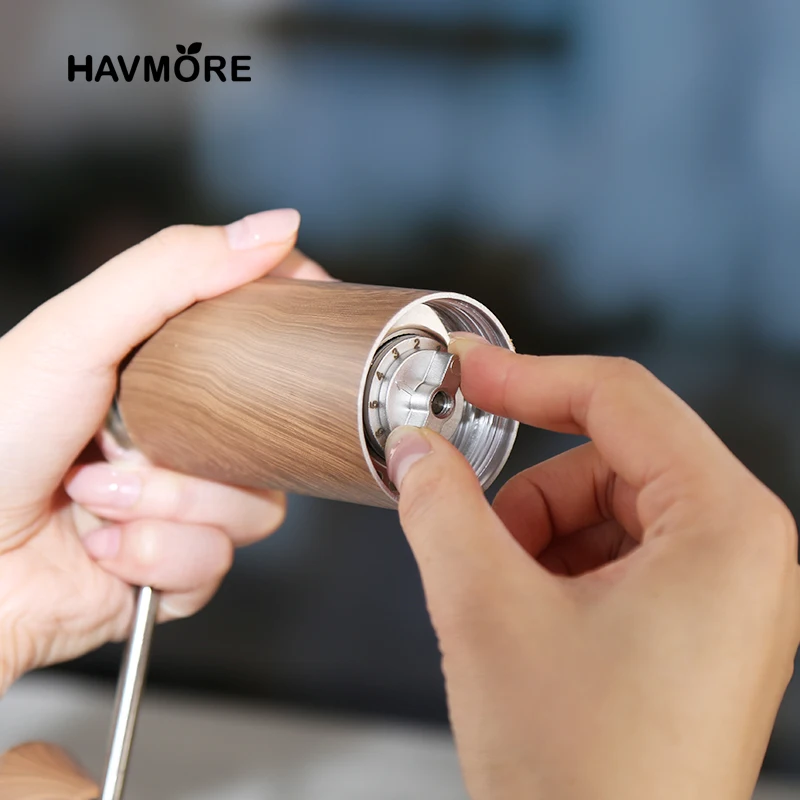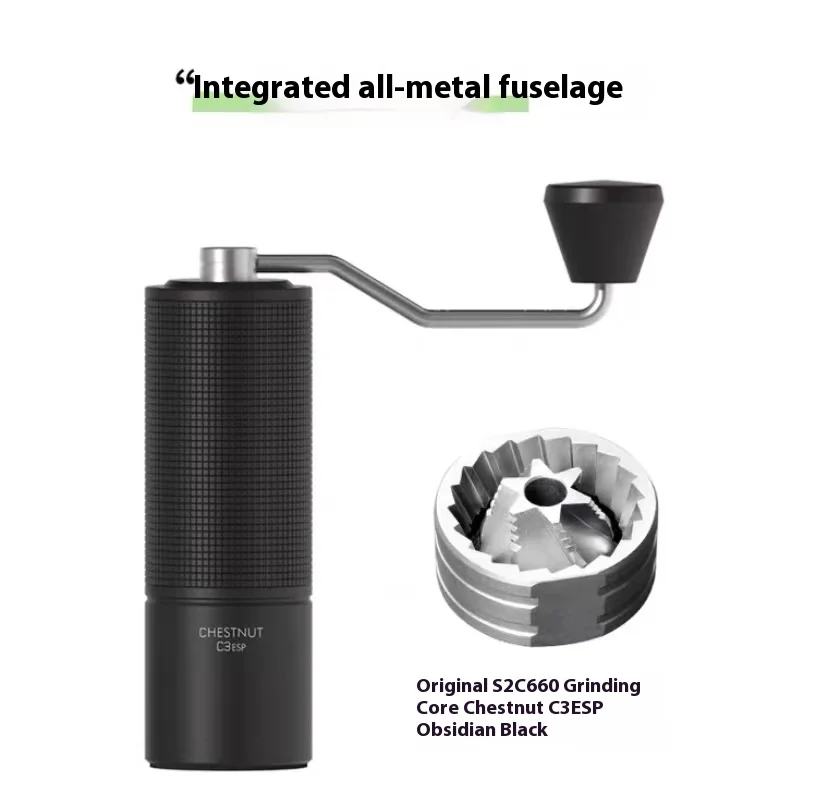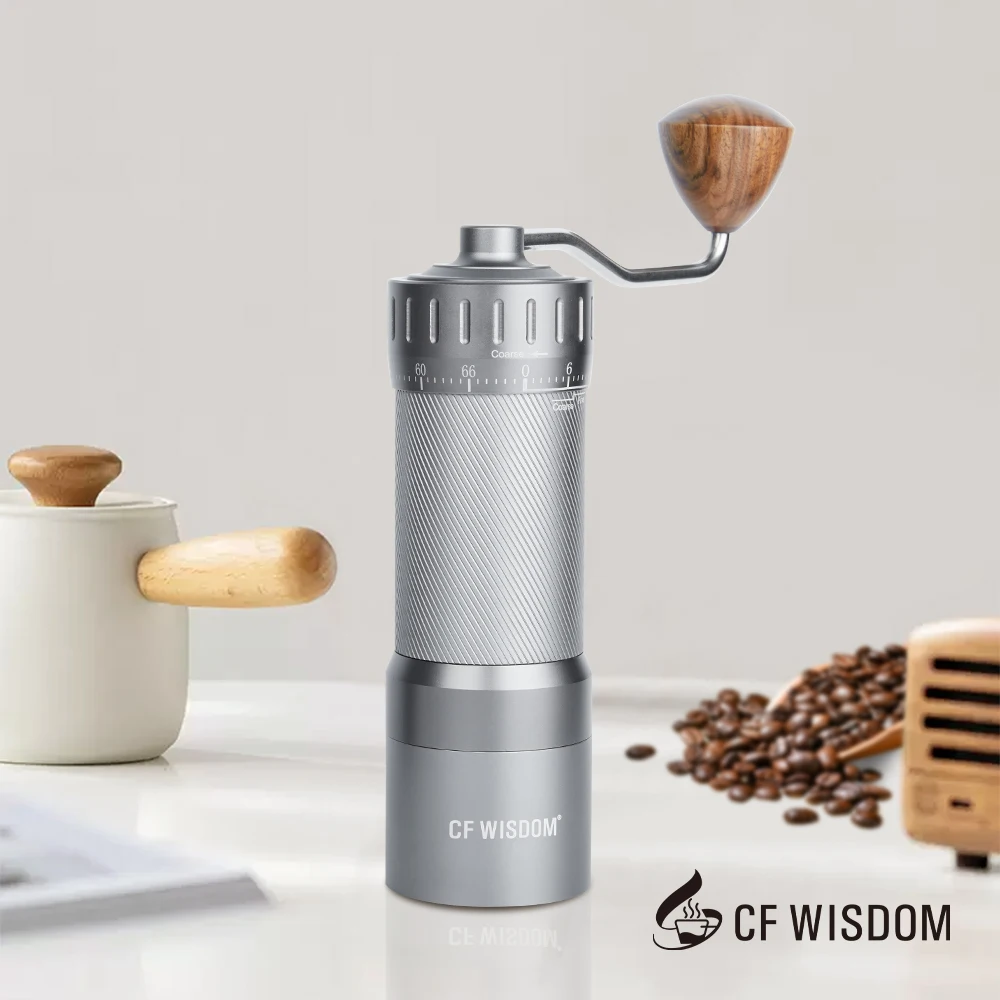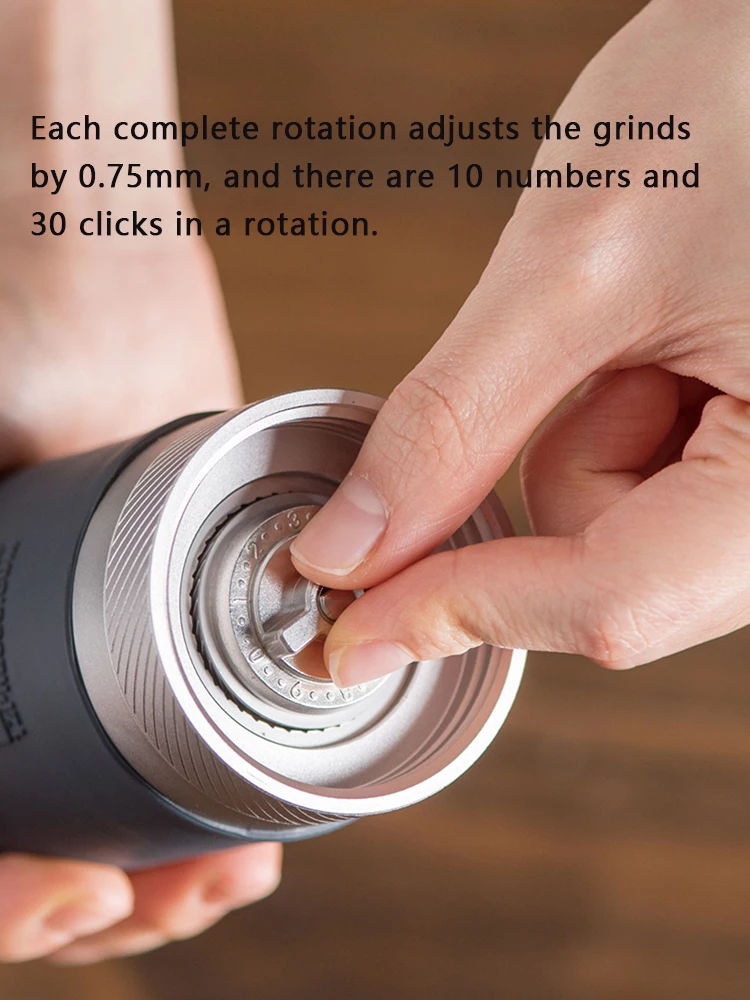Understanding Burr Grinder Mechanics and Technology
Coffee enthusiasts know that the journey to the perfect cup begins long before brewing. It starts with the humble coffee bean and how it’s ground. At the heart of quality grinding lies the burr grinder—a device that uses two abrasive surfaces (burrs) to crush coffee beans between them with remarkable precision.
Unlike blade grinders that chop beans randomly, burr grinders work by feeding beans between two textured surfaces that crush them to a consistent size. This consistency is crucial because uneven coffee particles extract at different rates, leading to muddy flavors and compromised brews.
The size of these burrs—typically ranging from 38mm in entry-level grinders to massive 98mm burrs in commercial machines—plays a significant role in determining grind quality and consistency. This relationship between burr size and grind quality forms the central question of our exploration: Do larger burrs inherently provide better control, especially when grinding fine for methods like precise espresso preparation?
The answer affects not just espresso lovers but anyone seeking optimal extraction from their chosen brewing method. Before investing in your next manual coffee burr grinder, understanding this relationship can help you make a more informed decision that matches your coffee preparation needs.
The Physics Behind Burr Grinding: Size Matters
When it comes to coffee grinding, the physical principles behind burr operation reveal why size truly matters. Larger burrs offer several mechanical advantages that directly influence grind quality.
First and foremost is simple geometry—a larger diameter burr creates more cutting surface area. This increased surface means:
- More cutting edges simultaneously engage the beans
- Greater precision in particle size generation
- Improved bean movement through the grinding chamber
- Enhanced ability to achieve uniform particle distribution
Consider the difference between typical 40mm home grinders versus 64mm+ commercial models. The larger burrs in commercial grinders provide significantly more cutting surface—often 2.5 times more—which translates to more efficient bean processing. With each rotation, the larger burr processes more beans while maintaining precision.
Perhaps most importantly, larger grinding surfaces distribute the workload across more cutting edges. This reduces the strain on any single portion of the burr, resulting in more consistent particle size throughout the grind process. The impact of burr diameter on coffee grind quality becomes especially apparent when attempting to achieve the precise consistency required for espresso extraction.
The laws of physics also come into play regarding rotational dynamics. Larger burrs, with their increased mass and momentum, tend to maintain more stable grinding action under load. This stability translates to fewer fluctuations in particle size—a critical factor when seeking the perfect extraction.
Flat vs. Conical Burrs: Different Approaches to Precision
When exploring burr grinders, you’ll encounter two primary design philosophies: flat and conical burrs. Each offers distinct advantages for achieving precision grinds, and their characteristics interact with size in fascinating ways.
| Characteristic | Flat Burrs | Conical Burrs |
|---|---|---|
| Particle Shape | More uniform | Bimodal distribution |
| Heat Generation | Higher | Lower |
| Typical Size Range | 50-98mm | 38-68mm |
| Grind Consistency | Very consistent | Varies with design |
| Best Applications | Espresso, precision brewing | Versatile across methods |
Flat burrs consist of two parallel rings with grinding surfaces facing each other. When coffee passes between them, the result is a notably uniform grind with particles of remarkably similar size. This uniformity makes flat burr hand grinders particularly excellent for espresso, where extraction consistency is paramount.
Conical burrs, by contrast, feature a cone-shaped center burr that fits inside a ring-shaped outer burr. This design creates a grinding path where beans are broken down progressively as they move through the narrowing space. Conical burrs typically produce what coffee experts call a “bimodal distribution”—a mix of both target-size particles and some finer particles—which some believe contributes to body and complexity in certain brewing methods.

Heat management represents another key difference. Flat burrs, with their larger surface area in constant contact, tend to generate more heat during grinding. Conical burrs generally run cooler due to their design, which can help preserve delicate flavor compounds in the coffee.
Size considerations affect each design differently. Larger flat burrs especially benefit from their increased surface area for precision grinding, while conical burrs gain improved consistency and reduced heat generation as they increase in size.
The Superior Benefits of Larger Burrs
The advantages of larger burrs extend beyond simple mechanics, delivering meaningful improvements to your coffee experience in several ways:
Enhanced particle size consistency – Larger burrs create more uniform coffee grounds, resulting in even extraction and balanced flavor. This consistency is particularly noticeable when comparing identical beans ground with 40mm versus 64mm burrs, where the larger burrs produce noticeably more uniform particles.
Reduced fines production – Fines are those tiny coffee dust particles that lead to bitter, over-extracted flavors. Larger burrs typically generate fewer fines because they cut more precisely and generate less friction. The result is cleaner cup clarity and reduced muddiness in the final brew.
Faster grinding with less heat – Larger burrs process more coffee per rotation, reducing grinding time by 30-50% compared to smaller alternatives. This efficiency minimizes heat generation during grinding, preserving delicate volatile compounds that contribute to aroma and flavor complexity.
Superior adjustment precision – The increased circumference of larger burrs allows for more gradual adjustment mechanisms. When adjusting from one setting to another, the larger circumference translates small adjustments into more subtle changes in the gap between burrs.
Improved flavor clarity – By creating more consistent particles with fewer fines and generating less heat, larger burrs help preserve the coffee’s intended flavor profile. This leads to greater clarity in the cup, with distinct flavor notes becoming more identifiable.
These advantages combine to create a superior grinding experience, which is why professional baristas and serious enthusiasts often gravitate toward grinders with larger burrs. The definitive guide to coffee grinder burr size demonstrates that while larger isn’t always necessary, the benefits are tangible for those seeking maximum precision.
Why Larger Burrs Excel at Espresso-Fine Grinds
Espresso preparation demands extraordinary precision. The pressurized brewing method requires an exceptionally fine, consistent grind to create the resistance necessary for proper extraction. This is precisely where larger burrs demonstrate their greatest advantage.
When grinding for espresso, coffee particles must be reduced to a size roughly equivalent to table salt grains—about 250-350 microns. At this fine setting, even minimal variance in particle size dramatically affects water flow through the coffee puck. Larger burrs excel in maintaining consistency at these fine settings for several reasons:
Enhanced micro-adjustment capability – The larger circumference of big burrs means each tiny turn of the adjustment mechanism creates a more precise change in the gap between grinding surfaces. This allows baristas to dial in the exact setting needed for optimal flow rate—sometimes adjusting extraction time by mere seconds.
Critical reduction in fines – When grinding for espresso, excessive fines can lead to channeling (water finding paths of least resistance through the puck) and over-extraction. Larger burrs typically produce fewer fines at espresso settings, resulting in more even extraction and balanced flavors.
Temperature stability advantages – The heat-dissipation benefits of larger burrs become especially important for espresso grinding. Lower grinding temperatures help preserve volatile oils responsible for crema quality and aromatic complexity in the final shot.

Understanding the relationship between burr size and extraction quality helps explain why commercial espresso grinders feature such massive burrs—often 64mm or larger. For home enthusiasts seeking café-quality results, investing in a quality espresso grind setting system with appropriately sized burrs can significantly impact shot quality, allowing for the precise control needed to master this demanding brewing method.
The Critical Role of Burr Alignment
While larger burrs offer numerous advantages, their benefits can be completely undermined without proper alignment. In fact, as burrs increase in size, alignment becomes increasingly critical to achieving their full potential.
Alignment refers to how precisely the two burrs are positioned relative to each other. When perfectly aligned, the grinding surfaces maintain a consistent distance throughout their entire circumference. However, even minor misalignment—sometimes as little as 0.1mm—can significantly impact grind quality in the following ways:
- Creates inconsistent particle sizes across different sections of the burr
- Produces more fines as beans get pulverized in tighter sections
- Generates uneven extraction due to mixed particle sizes
- Causes premature burr wear in areas with closer contact
The importance of alignment increases with burr size because:
• Larger diameter means greater potential for variance across the grinding surface
• Small angular misalignments translate to larger linear discrepancies at the edge
• The precision advantages of larger burrs are negated by poor alignment
• Higher forces involved can amplify the effects of misalignment
This explains why a modestly-sized but perfectly aligned grinder often outperforms a larger grinder with alignment issues. When evaluating grinders, the quality of the burr alignment mechanisms should be considered just as important as the burr size itself.
Visual indicators of misaligned burrs include uneven wear patterns, inconsistent grind appearance, and the need to adjust settings frequently. Some premium grinders feature tools or systems for user alignment, while others require professional calibration to achieve optimal performance.
Beyond Size: Other Crucial Factors for Grind Quality
While burr size significantly impacts grind quality, it’s just one piece of a complex puzzle. Several other critical factors work in concert with size to determine overall grinding performance:
Burr Material Quality
The material composition of burrs dramatically affects their performance and longevity. Ceramic burrs retain their sharpness longer but are more brittle and prone to cracking if foreign objects enter the grinder. Steel burrs—particularly hardened steel variants—offer excellent durability and precision but may need replacement after grinding hundreds of pounds of coffee. Premium burr materials directly influence the consistency of particle size regardless of diameter.
Burr Design and Tooth Geometry
The specific cutting pattern engineered into the burr surfaces plays a crucial role in grind quality. Some designs excel at producing consistent medium grinds, while others are optimized for espresso or filter coffee. The shape, depth, and arrangement of teeth on the burr surface can be as important as size in determining the final grind quality.
Motor Power and Stability
The motor driving the burrs must provide consistent power with minimal vibration. Fluctuations in RPM during grinding can create inconsistent particle sizes, while vibrations can affect burr alignment during operation. Quality precision manual grinders often outperform electric grinders with more powerful motors but poorer stability.
Adjustment Mechanism Precision
The system that controls the distance between burrs determines how precisely you can dial in your grind. Stepless adjustment mechanisms offer infinite control but can be difficult to reproduce exactly, while high-quality stepped adjusters provide consistent, repeatable settings with adequate precision for most brewing methods.
Grinder Build Quality and Stability
The overall construction of the grinder—including frame rigidity, bearing quality, and shaft stability—directly impacts grind consistency. A well-built grinder with smaller burrs may outperform a poorly constructed grinder with larger burrs because stability during operation is crucial for maintaining alignment and consistent grinding pressure.
Understanding these additional factors helps explain why simply choosing the largest available burr size doesn’t guarantee superior results. The synergy between all these elements ultimately determines grind quality.
Real-World Testing: Do Larger Burrs Live Up to the Hype?
Moving beyond theory to practical application, the question remains: Can coffee enthusiasts actually taste the difference that larger burrs make? Based on controlled testing and analysis, the answer is nuanced but generally affirming.
Particle distribution analysis shows measurable differences between burr sizes. When comparing grounds from 38mm, 55mm, and 64mm burrs (using identical beans and grind settings):
• The 64mm burrs consistently produce the most uniform particle distribution
• Smaller burrs typically generate 15-25% more fines (particles under 100 microns)
• Larger burrs create more consistent medium-sized particles critical for even extraction
These physical differences translate to measurable extraction variations. Coffee ground with larger, well-aligned burrs typically achieves:
- Higher extraction yields (often 0.5-1% higher) due to more even particle size
- More consistent shot times for espresso (less variation between shots)
- Better repeatability when recreating favorite recipes
But do these technical advantages translate to taste? In blind tasting sessions, experienced coffee professionals can indeed identify differences:
• Clarity of flavor notes is generally higher with coffee ground by larger burrs
• Separation of distinct taste components (acidity, sweetness, etc.) is more pronounced
• Less bitterness and astringency from over-extracted fines
However, it’s important to note that the perceptible difference diminishes as other variables come into play. The ultimate espresso grind size chart demonstrates how brewing parameters must be adjusted alongside grind size to achieve optimal results.
For average coffee drinkers, the most noticeable improvements come when upgrading from very small burrs (under 40mm) to medium-sized burrs (50-60mm). The difference between 65mm and 85mm burrs may be detectable only to trained palates or when brewing methods that particularly benefit from extreme consistency, such as espresso.
Practical Considerations for Choosing Your Grinder
While larger burrs offer technical advantages, practical considerations should guide your purchase decision. Your optimal choice depends on brewing methods, budget, space constraints, and usage patterns.
| Brewing Method | Recommended Min. Burr Size | Key Considerations |
|---|---|---|
| Espresso | 50mm+ | Precision adjustment, minimal retention |
| Pour Over | 40mm+ | Consistency at medium grinds |
| French Press | 38mm+ | Uniform coarse particles |
| All Methods | 55mm+ | Versatility across grind ranges |
Budget Implications
Larger burrs typically come with higher price tags. Entry-level grinders with 38-40mm burrs often cost $100-200, while 55mm+ burr grinders generally start at $300 and can reach well over $1,000. Consider whether the improved consistency justifies the investment based on your coffee preferences and palate sensitivity.
Space Requirements
Grinders with larger burrs generally require more counter space. Before upgrading, measure your available space and consider whether a larger grinder will fit comfortably in your coffee preparation area. Some premium manual grinders offer relatively large burrs in compact bodies, offering an excellent compromise.

Grind Retention Concerns
Larger burr chambers can sometimes trap more ground coffee between uses. This “retention” can be problematic when switching between beans or brewing methods, as old grounds mix with fresh ones. Many modern premium grinders address this with low-retention designs, but it’s worth investigating before purchase.
Workflow and Volume Needs
Consider how much coffee you typically grind and how frequently. Larger burrs grind faster, making them ideal for households brewing multiple cups or small offices. For single-cup brewers, the speed advantage may be less significant than other factors like grind quality or adjustment precision.
Fine Adjustment Hand Grinder, Precision Manual Grinder, Travel Coffee Grinder
Price range: $185.11 through $494.63 Select options This product has multiple variants. The options may be chosen on the product pageHand Burr Grinder, Hand Crank Coffee Grinder, Manual Espresso Grinder, Portable Coffee Grinder
Price range: $262.72 through $300.22 Select options This product has multiple variants. The options may be chosen on the product pageManual Burr Mill, Manual Coffee Grinder Stainless Steel, Manual Coffee Mill Grinder, Mechanical Coffee Grinder
Price range: $127.26 through $130.32 Select options This product has multiple variants. The options may be chosen on the product pageHand Burr Grinder, Manual Coffee Grinder Stainless Steel, Precision Manual Grinder
Price range: $183.64 through $187.52 Select options This product has multiple variants. The options may be chosen on the product page
At Savor Suite, we understand that finding the perfect manual espresso grinder involves balancing these considerations against your specific needs. The best grinder isn’t necessarily the one with the largest burrs—it’s the one that best fits your coffee routine, brewing methods, and quality expectations.
Maintaining and Optimizing Your Burr Grinder
To maximize performance and longevity, proper maintenance of your burr grinder is essential regardless of burr size. Regular care ensures consistent grind quality and extends the life of your investment.
Regular cleaning prevents flavor contamination – Clean your burrs every 1-2 weeks or when changing bean varieties. Remove old coffee oils that can turn rancid and affect flavor. For thorough cleaning, use grinder-specific cleaning pellets or uncooked rice (for some models) to absorb oils before disassembling for deeper cleaning.
Burr seasoning improves performance – New burrs often perform better after “seasoning”—grinding approximately 5-10 pounds of coffee to smooth microscopic burr edges. This process reduces fines production and improves consistency over time. Consider using inexpensive beans for this process rather than wasting your specialty coffee.
Calibration maintains optimal alignment – Check burr alignment periodically, especially after cleaning or if you notice inconsistent grinds. Some grinders allow user calibration by adjusting the burr carrier position, while others may require professional service.
Address static issues proactively – Combat static buildup (which causes grounds to stick to surfaces) by adding a few drops of water to beans before grinding—a technique called the “Ross Droplet Technique.” This reduces messy grind retention and improves dose consistency.
Monitor for wear indicators – Watch for signs that burrs need replacement, including increased grinding time, inconsistent particle size, and difficulty achieving fine grinds. Steel burrs typically last for 500-1500 pounds of coffee before replacement is recommended.
Quality all-metal hand grinders with proper maintenance can provide excellent performance for many years. The durability of high-quality burrs, particularly in manual grinders that operate at lower speeds, often exceeds that of their electric counterparts when properly maintained.
Frequently Asked Questions About Burr Size and Grind Quality
Are larger burrs always better?
Not necessarily. While larger burrs generally offer improved consistency and speed, factors like alignment, material quality, and design are equally important. A well-aligned 50mm burr set can outperform poorly manufactured or misaligned 65mm burrs. For home users, the sweet spot often lies in the 48-65mm range, balancing performance with practicality.
Will I taste the difference between 40mm and 65mm burrs?
Most enthusiasts can detect differences in cup clarity and flavor separation when comparing these sizes, particularly for espresso and precision brewing methods like pour-over. The difference becomes more pronounced with lighter roasts and single-origin coffees where flavor nuances are more distinct.
How often should I replace my burrs?
Steel burrs typically maintain optimal performance for 500-1500 pounds of coffee depending on quality and usage. Ceramic burrs last longer but are more susceptible to damage from foreign objects. Professional-grade titanium-coated burrs can last significantly longer. Rather than tracking pounds, watch for performance indicators like increased grinding time or inconsistent results.
Can I upgrade just the burrs in my existing grinder?
Usually not. Burrs are designed specifically for their grinder model, with precise dimensions and mounting systems. Attempting to fit larger burrs in a grinder not designed for them would require significant engineering modifications and likely compromise performance.
How much faster do larger burrs grind?
As a general rule, grinding speed increases proportionally with burr diameter. A 64mm burr set might grind twice as fast as a 40mm set under similar conditions. For a typical espresso dose, this could mean 15 seconds versus 30-40 seconds of grinding time.
Are flat or conical burrs better for espresso?
Both can excel at espresso grinding when properly designed. Flat burrs typically produce more uniform particle sizes, which some prefer for “clean” flavor profiles. Conical burrs often generate a bimodal distribution that some find creates more body. The difference is subtle enough that burr quality and alignment matter more than the flat versus conical distinction.
The Bottom Line: Are Larger Burrs Worth the Investment?
After examining the physics, testing results, and practical considerations, we can now answer our central question: Do larger burrs deliver finer grind control?
The evidence suggests that larger burrs do indeed offer superior grind consistency, particularly at finer settings where precision matters most. The increased surface area, improved heat dissipation, and mechanical advantages of larger grinding surfaces translate to measurable improvements in particle distribution uniformity and adjustment precision.
However, the value proposition depends heavily on your coffee habits:
For espresso enthusiasts, the investment in larger burrs (50mm+) is generally worthwhile. The improved consistency at fine settings directly translates to better extraction, more predictable shot times, and enhanced flavor clarity. If espresso is your primary brewing method, prioritizing burr size alongside alignment quality and adjustment precision will yield noticeable improvements.
For filter coffee specialists brewing pour-over, AeroPress, or drip coffee, the benefits of extremely large burrs (beyond 55mm) show diminishing returns. A well-designed 48-55mm burr set offers excellent consistency for medium grinds, and factors like burr geometry and alignment become relatively more important than sheer size.
For multi-method brewers who regularly switch between brewing techniques, versatility becomes key. A quality grinder with 50-60mm burrs offers an excellent compromise, providing sufficient precision for occasional espresso while excelling at medium to coarse grinds for other methods.
Remember that burr size is just one factor in a complex system. A holistic approach—considering burr design, material, alignment precision, and overall build quality—will lead to better results than focusing solely on diameter. The perfect grinder balances all these factors while meeting your specific needs and budget constraints.
Ultimately, for those who can appreciate the nuances in their cup, investing in a grinder with appropriately sized, quality burrs represents one of the most impactful upgrades to your coffee experience—often more significant than spending the same amount on a more expensive brewing device.







